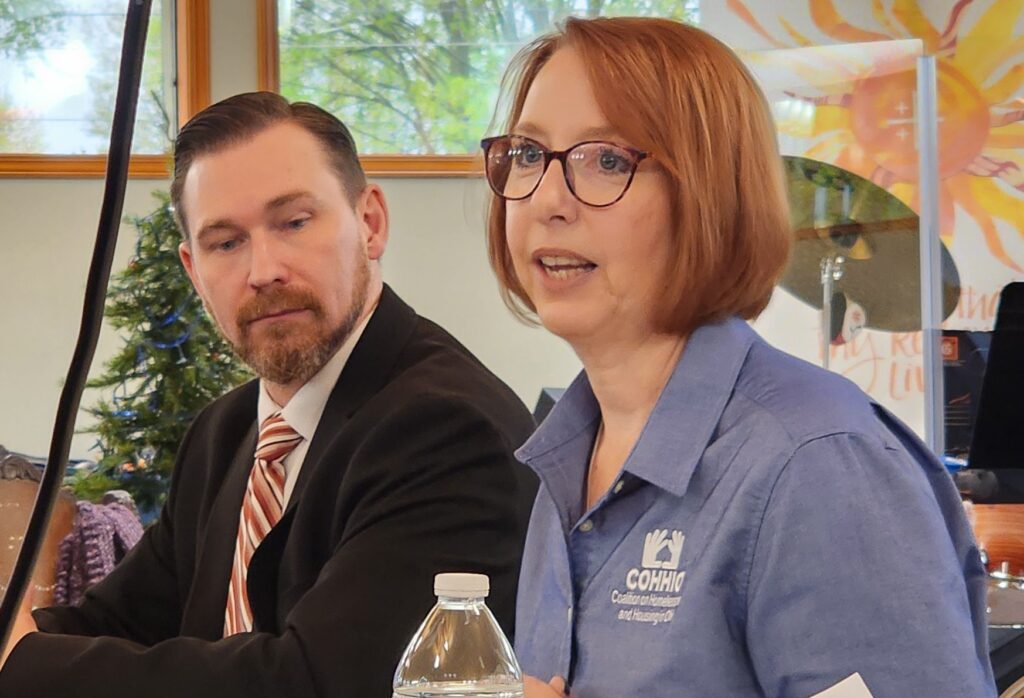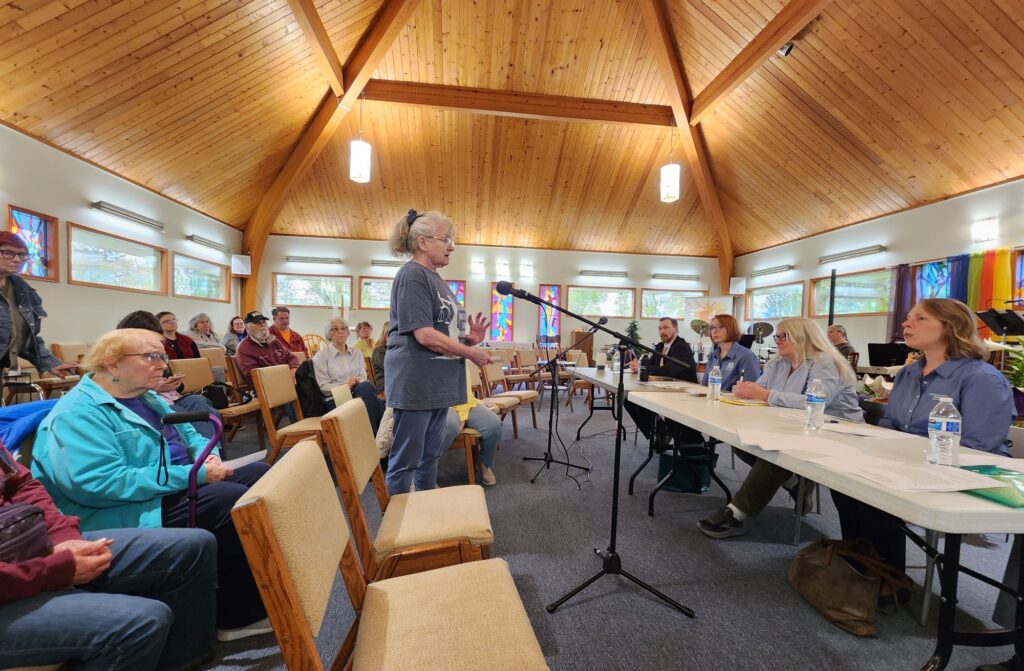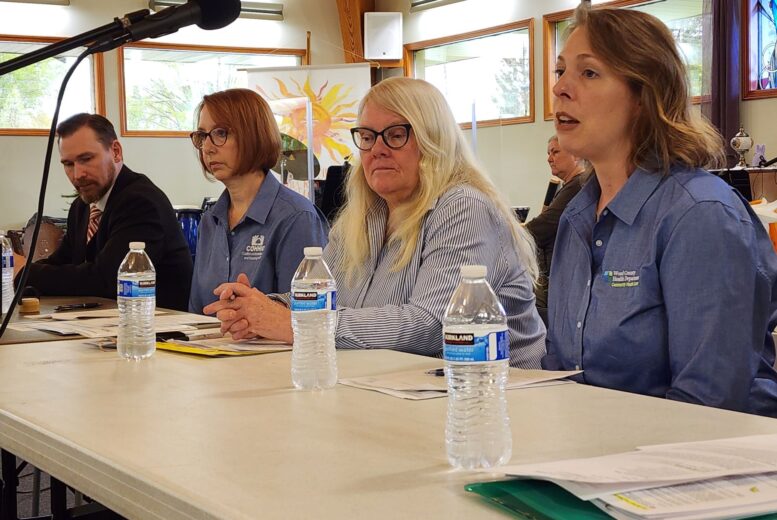By JAN McLAUGHLIN
BG Independent News
As America’s safety net is being pulled out from under those most in need, local residents gathered Saturday to learn where the gaps are growing and how they can help.
A grim picture was painted by local agencies that currently keep low income, underinsured and unhoused residents from crashing through the safety net. They see their funding at risk, and those they serve spiraling to new depths.
The gathering, hosted by the League of Women Voters of Bowling Green at Peace Lutheran Church, focused on agencies that provide services for health, housing and hunger.
Others were invited to attend, to share concerns about funding cuts to senior citizen programs, veterans services, PBS, libraries and schools. “There are a lot of afraid people out there,” said David Neuendorff, a member of the League of Women Voters.
For many Americans, the fear is death by a thousand cuts – cuts in funding, cuts in staffing, cuts to entire programs. The cuts are so widespread and deep that shortages in one program cannot be rescued by others coming to their aid.
Speaking on the panel were four Bowling Green residents with expertise in public health, housing and food: Ben Robison, Erin Hachtel, Karen Woods and Lindsey Ruivivar.
Public health
Robison, health commissioner for Wood County, is carefully watching for proposed funding changes. Last month, the health department learned it had lost approximately $4 million in federal funding that had already been approved.
“We don’t really know what we’re going to see,” Robison said.
But public health officials have seen the federal shift from focusing on infectious diseases to chronic disease instead. Some prevention programs are seeing funds being gutted.
While Robison welcomes the focus on chronic diseases, he does not want it to be at the expense of vaccination programs – especially with the recent outbreaks of measles across the country.
Robison said the health department is focused on collecting good data so smart decisions can be made.

Housing
Erin Hachtel works for the Coalition on Homelessness and Housing in Ohio, which works to end homelessness and promotes decent, safe, affordable housing for all.
Since January, the Trump administration has issued executive orders that have attempted to cancel grants already approved for communities and organizations, Hachtel said.
“As we all should know by now, executive orders are not laws. They are directions from the executive branch to agencies and departments. The grants have already been appropriated by Congress, so restricting or canceling them legally requires an act of Congress,” Hachtel said.
Multiple court orders from judges across the political spectrum and country have required that the Trump administration reinstate the grants, she added.
Hachtel highlighted two housing worries:
- Threats to enforcement of fair housing laws. In February, grants were unlawfully terminated to dozens of organizations that investigate discrimination complaints and educate the public about fair housing law, which protects veterans with disabilities, people of color, survivors of sexual harassment, and families with children.
- Cuts to staff and threats to grants at the U.S. Department of Housing and Urban Development. There are more than 387,000 people in Ohio who are supported by federal housing program funds – veterans, seniors, children, families and individuals with disabilities.
Hachtel’s agency, COHHIO, earlier this month called on the Ohio House to remove an amendment to the biennium budget that would gut the Ohio Housing Trust Fund. That program is a critical source of funding for home repair and accessibility modifications for vulnerable people. It allows seniors and people with disabilities to continue living in their own homes instead of nursing homes and institutions.
Hunger
Karen Woods, an attorney, who has volunteered at food pantries for nearly 60 years, shared her concerns about funding cuts being made to Meals on Wheels, WIC (Women, Infants and Children), school lunches, SNAP, HeadStart and daycare centers.
A study cited by the Ohio Association of Food Banks last August showed 49% of households using food banks had no member who was employed. Of those who were unemployed, 58% reported they were too sick or disabled to work, and 44% said they were retired. More than half said they were not receiving Supplemental Nutrition Assistance Program benefits, formerly known as food stamps.
On April 1, Ohio cut $15 million from food banks in the state. And $1.1 trillion in federal cuts are being eyed in Medicaid and SNAP over 10 years. Currently, 41.7 million Americans get SNAP, which is 12% of the population.
“What does all this change mean for food banks, schools, food stamps, WIC, Meals on Wheels?” Woods asked. “It means that our local food banks are not going to meet the needs of the food-insecure in Wood County.”
“We as a society will have to live with the consequences,” she said.
Inevitably, as Woods assists at local food banks, she finds that those picking up food feel compelled to explain why they are there.
“More often than not, they have a real need to tell me their story,” so she doesn’t think they are lazy or grifters. “Usually, their stories start with an illness or injury at work.” Some are raising grandchildren. Others are going through divorce or can’t afford to replace a car that has broken down. They get evicted. Their lives spiral.
“This could happen to any of us,” Woods said.

Health care
Lindsey Ruivivar, head of the Community Health Center at Wood County Health Department, talked about the vital services provided for people of all ages, all insurances, and sliding fees for those with none.
“We are open to everyone,” she said.
The federally-funded health center offers general medical, dental, mental health care, plus a pharmacy. Approximately half of those served have Medicaid, she said.
The facility tends to serve sicker patients, who have put off seeking care. Ruivivar worries about the fragile partnership between the federal government, which pays 90% of the enhanced Medicaid program, and Ohio’s state government which picks up the other 10%. Any weakening of the federal portion could trigger an end to the state portion.
That would be very shortsighted.
“There’s value in investing in public health programming,” Robison said.
“We are a very good use of federal funding,” said Ruivivar, who considers Medicaid as a vital part of economic and workforce development.
Resources already stretched
Also at Saturday’s meeting, Sandra DeSteno, of the local 211 system that links people with resources, shared her concerns.
DeSteno talked about how one misfortune can lead to a family or individual spiraling out of control. Someone who can’t afford auto insurance, can’t drive to work, and then loses their housing.
“It is such a slippery slope,” she said. “They need so much to dig themselves out of the places we have put them in society.”
Though not as obvious as bigger cities, Bowling Green does have homeless people, DeSteno said. “And it’s going to get infinitely worse.”
Resources are already stretched for local agencies helping those in need, she said.
“211 can’t connect people to resources that don’t exist,” she said.
Woods said she always believed that “decent governments” provided for those who can’t provide for themselves. But that is not a priority of this administration.
Hachtel said that foundations and corporations are feeling stretched, and won’t be able to stitch together a good safety net.
And Ruivivar said public health is feeling the same pinch. “We’re already doing more with less. There’s only so much more you can do with less.”
How to help
For those who want to help, Woods suggested that they write to their legislators. For more concrete actions, she suggested:
- Local gardeners plant an extra row or two of vegetables to donate to local food pantries.
- When grocery shopping, pick up extra tuna and peanut butter to drop off at food pantries.
- Donate other items like dog and cat food, adult diapers and feminine hygiene products.
- Donate money to help pay for unpaid school lunches.
Another man at Saturday’s meeting also suggested that the public be kind to federal workers like those at Social Security offices. “These people don’t know from one minute to the next if they are going to be there,” he said.





